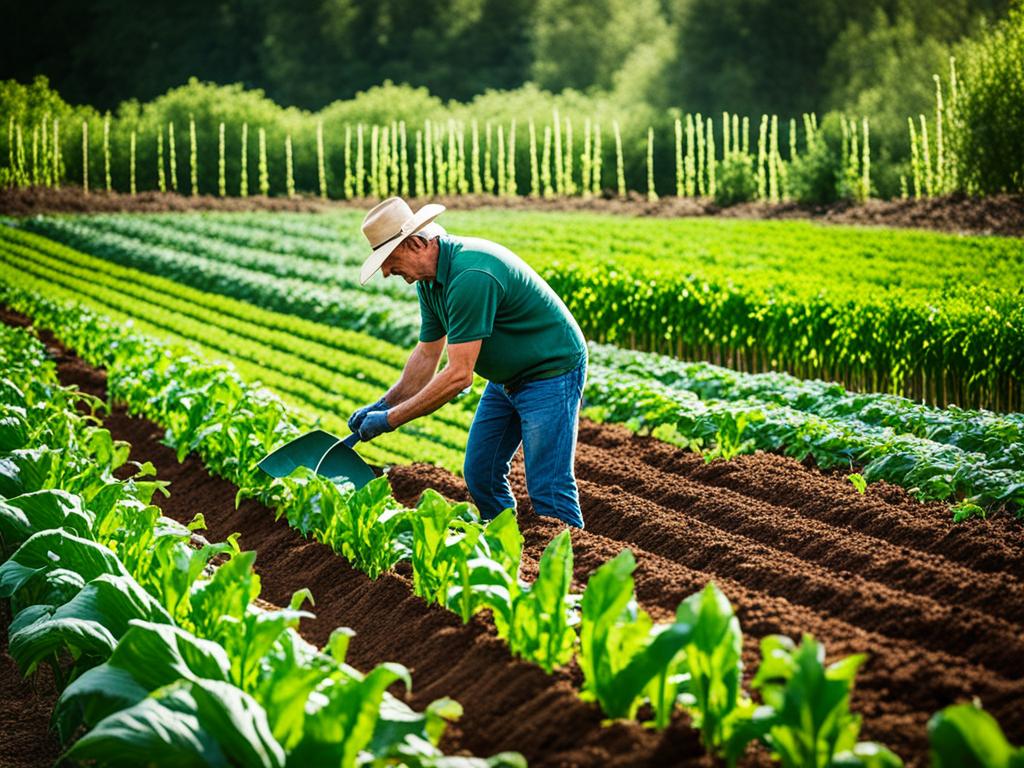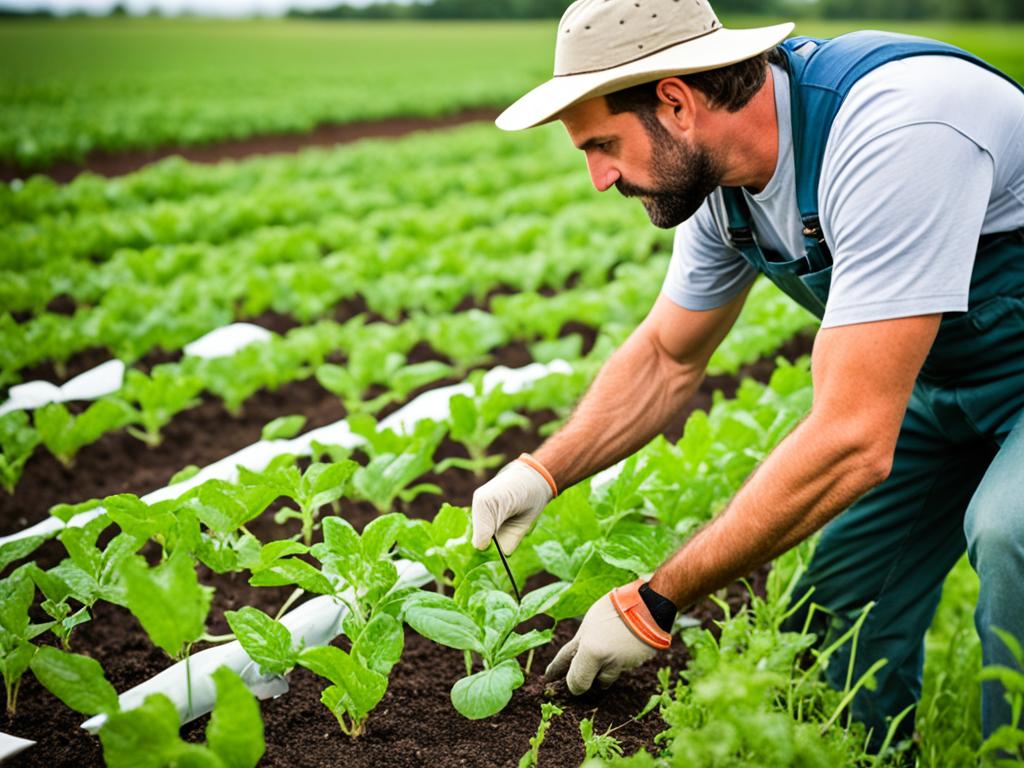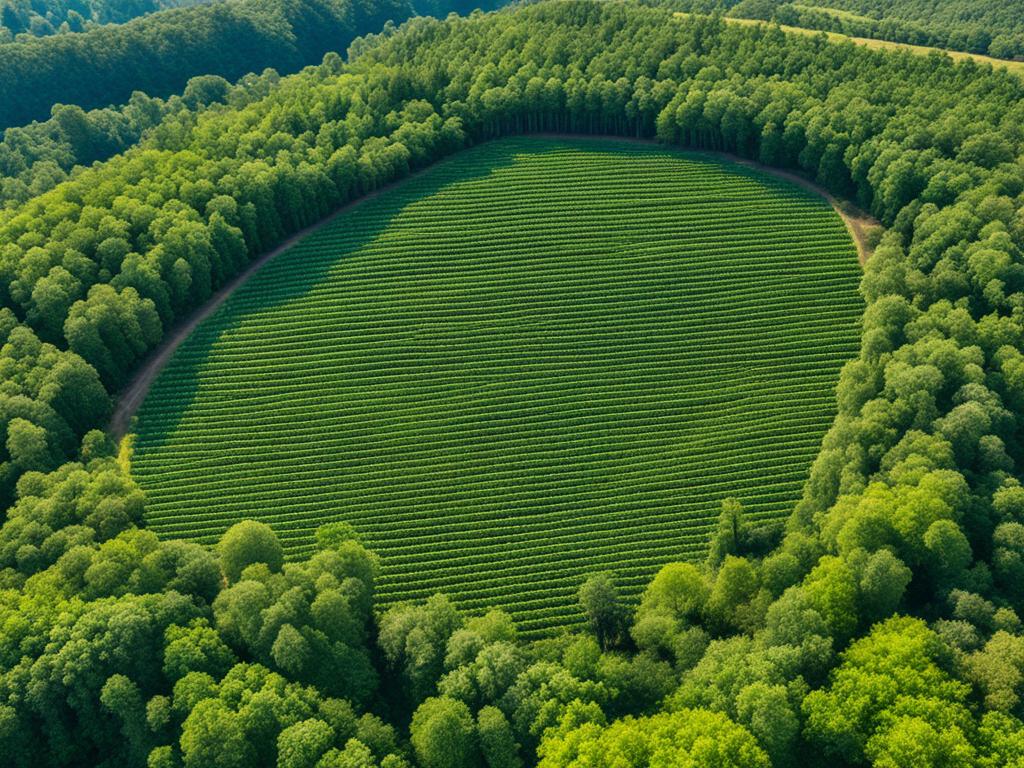Agriculture can strain natural resources and the planet. Sustainable agricultural practices aim to protect nature. They also work on expanding our resource base and keeping soil fertility high. Sustainable agriculture is about making farms profitable while being kind to the environment. It seeks to boost the quality of life for those living on farms and for all of us. It does this by increasing food and fiber production using methods that last a long time. These methods help keep the earth healthy and make sure farms stay in business.
Key Takeaways
- Sustainable agriculture practices aim to maximize food production while minimizing environmental impact.
- Sustainable farming can lead to stronger local economies and increased economic opportunities for small-scale farmers.
- Sustainable agriculture encourages social equity and promotes a more equitable food system.
- Sustainable agriculture practices contribute to a more efficient, stable, and resilient food system.
- Sustainable agriculture methods help improve food security, conserve resources, and promote a healthier planet.
What is Sustainable Agriculture?
Sustainable agriculture works with nature to produce food. It aims to cut down harm to the environment. This way, we can keep producing food without hurting the planet. It involves using local resources, using less water, and natural fertilizers.
This helps keep the soil healthy and cuts down on erosion. This way, we protect the earth for those who come after us.
Integrating Environmental Stewardship
Sustainable farming aims to take care of our environment. It uses methods like growing different crops in the same field.
It also uses less soil plowing and covers the bare ground with plants. These methods help keep the soil fertile, stop soil from washing away, and reduce the need for chemicals.
Promoting Ecological Harmony
Sustainable farming tries to live in peace with the natural world. It uses systems like planting trees among crops and controlling pests without chemicals.
These methods help keep a variety of life, prevent soil damage, and balance the ecosystem. This is key for lasting farms and a healthy environment.
Balancing Productivity and Conservation
It’s all about finding a balance between farming a lot and taking care of our land. The focus is on making plenty of food and protecting nature.
This way, we can feed ourselves today and in the future without harming the environment. It’s all about farming wisely to last long.
Importance of Sustainable Agriculture
By 2050, the world may have about 9 billion people. To feed everyone, we’ll need 70% more food. This puts a big strain on our environment and farms. Sustainable agriculture is key. It helps produce more food without harming the planet.
Meeting Food Demands of a Growing Population
Sustainable farms are crucial for feeding more people. They use methods to boost yields and make our food supply stable. Plus, they cut down on using up things like oil, save nature, and lower chemical use. This keeps farming healthy for the future.
Protecting Natural Resources
Sustainable agriculture helps keep our land, water, and nature safe. Farms do this by using cover crops, tilling less, and watching pests. This saves soil, stops it from washing away, and lessens harm to nature. It helps the land grow food for years to come.
Enhancing Economic Viability
Sustainable farms are also good for business. They spend less on costly stuff like chemicals. This cuts costs and makes more profits. Also, their products are often healthier and worth more. This helps farmers earn more and boosts local economies.}}
Crop Rotation and Diversity
Rotating crops and embracing diversity can have many benefits. This includes healthier soil and improved pest control. By using practices like intercropping and multiyear crop rotations, we protect our soil. This helps prevent erosion and keeps weeds under control.
Intercropping and Mixed Cropping
Intercropping, or mixed cropping, means growing different crops together. This method can make our harvests more diverse. It also helps with nutrient use, pest management, and disease control. By mixing crops, we make our farms stronger and less dependent on chemicals. This supports a healthier environment.
Complex Multiyear Rotations
Moving beyond the common one-year rotations, complex plans can do wonders. Using more than two crops in rotation increases productivity. It also boosts soil health. Including crops like alfalfa and small grains further enriches the soil. This method helps keep pests at bay and keeps the soil alive.

Good planning and tracking are key for crop success. Farmers must know which crops grew where before. With diverse rotations and planting several types together, we can gain many benefits. These include fighting diseases and pests, and managing our soil better. This leads to bigger harvests, protects the land, and makes the farm more resilient to change.
Cover Crops and Perennials
Cover crops, like clover, rye, or hairy vetch, are grown in the off-season. Otherwise, soils would be left bare. Perennial crops cover the earth year-round, keeping it alive. They are key for soil health. They stop erosion, put back soil nutrients, and control weeds, cutting down chemical use.
Recent numbers show more farmers are using cover crops. In 2017, 15.4 million acres were planted, up 50% from five years before. Eight states significantly increased their cover crop use. The number of farms using cover crops grew by 15.2% from 2012 to 2017.
Using cover crops leads to better yields. After five years, corn yields can increase by 3% and soybean yields by 4.9%. In 2012, a drought year, there were even bigger gains: 9.6% in corn and 11.6% in soybeans when cover crops were used.
Cover crops can greatly help in keeping the soil healthy. Legume cover crops add 50-150 pounds of nitrogen per acre. Non-legume types get 30-50 pounds. Some can even find and use 150 pounds per acre. Grass and legume mixtures add more biomass, nitrogen, stop weeds, and draw in helpful bugs and pollinators.
In the world of sustainable farming, cover crops are heroes. They lower the need for harmful chemicals. They make farming kinder to the planet. Legumes fix nitrogen, helping other plants grow. Grasses control erosion, make soil better, and add vital organic matter.
When picking cover crops, different seasons need different plants. Winter crops like rye stop erosion, while summer ones like cowpeas add nitrogen and feed animals. Fall crops like cereal rye and brassicas protect the soil and fight weeds. It’s wise to talk to local farm experts to choose the best covers for your area and goals.
Reduced or No-Till Farming
For many years, plowing or tillage was a go-to in farming. It was used for readying fields and controlling weeds. It led to soil loss because of erosion, which hurt the land’s health and productivity. On the other hand, reduced or no-till farming helps prevent this soil loss. It makes for a more lasting way to farm, guarding against erosion and boosting soil health.
Preventing Soil Erosion
No-till farming puts seeds straight into the ground without disturbing it. This cuts down soil erosion by over 80 percent. It keeps water clean and saves a major natural resource. By not tilling, the soil stays steady, stopping the loss of vital topsoil. Plus, it lowers fuel use by 50 to 80 percent. This saves money and is better for the earth.
Improving Soil Health
No-till and reduced-till ways also make agricultural soils healthier and more efficient. They guard the soil and add organic matter. That makes for soils that are fitter and bounce back better. Farms using no-till have seen a 135 percent jump in income. This is thanks to better soil that supports a bigger harvest over time.
Today, many farmers are moving towards no-till or reduced-till methods. They want to tackle soil erosion issues and make their farms more sustainable. With help from programs like those of the USDA and new farming tech, these methods are taking off. This growth is good news for the planet and for the farm’s bottom line.
Integrated Pest Management (IPM)
Integrated pest management (IPM) takes a long view on controlling pests. It prefers to prevent problems before they start rather than reacting after pests are spotted. By using a mix of biological controls, mechanical controls, and careful pesticide use, IPM aims to keep environmental harm low while managing pests effectively.
Biological and Mechanical Controls
IPM promotes the use of biological controls. This means turning to nature’s own methods, like using natural enemies to keep pests under control. The goal is to maintain a natural balance where good bugs outweigh the bad, reducing the need for chemical sprays.
In addition, mechanical controls are key in IPM. These are physical tactics, like erecting barriers or setting traps. Even just picking off pests by hand fits into this category. These methods cut down on chemical use, too.
Minimizing Chemical Pesticides
IPM doesn’t ban chemical pesticides outright, but it uses them as a last resort. When they’re needed, it pushes for choosing the safest options. The system is all about careful monitoring and choosing the best, most focused control measures.
With integrated pest management, farmers and gardeners can use fewer chemical pesticides. This move is good for the planet and can cut costs in the long run. It makes agriculture more sustainable and kinder to the environment.

Sustainable Agriculture: Practices and Benefits for the Environment
Sustainable agriculture has big benefits for our planet. It helps keep our soil healthy with methods like cover cropping and reduced tillage. This stops soil from washing away and keeps it rich. Also, it saves water through better irrigation and harvests rain to use later. Using solar and wind power in farming reduces harm to the environment even more.
Soil Conservation Methods
Cover cropping and not plowing as much keep our soil strong. This makes it hold water better and not blow away. These steps support the life under the ground and ensure we can farm well for the future.
Water Conservation Practices
Growing crops with less water means we use it wisely. Technologies like drip irrigation help with this. They’re important because they save water for everyone, now and in the future.
Renewable Energy in Agriculture
Using sun and wind for energy in farms is good for Earth. It cuts down on greenhouse gases that cause climate change. This means a brighter and greener tomorrow for all of us.
Integrating Livestock and Crops
Industrial farming often keeps plants and animals apart. But, research says combining them wisely can boost farms. This change leads to better outcomes in both productivity and earnings.
Efficient Nutrient Cycling
When farms mix animals with crops, they manage nutrients well. For example, using animal waste as crop fertilizer. This reduces the need for man-made fertilizers, which cuts costs. It also makes the farm more profitable overall. Adding animals to a crop farm can also enhance the soil. They bring more life to the earth, which helps plants grow better and fights off pests.
Enhancing Profitability
Having livestock can also cut down on waste by eating leftovers, spoiled crops, and more. This cuts costs and earns money during hard times. Combining crops with these animals can decrease the money spent on feeding them, especially when there’s not enough rain. It strengthens farms against tough times, like bad markets or changing weather. It also boosts the amount of food produced and the profit made by the farm.
Agroforestry Systems
Agroforestry mixes trees or shrubs with farming. This adds a lot of value to the land. It helps overcome the limits of traditional single-crop systems. Farmers gain from both better sustainability and higher productivity by blending trees with their crops.
Shade and Shelter for Crops
Agroforestry systems play a big role in providing shade and shelter for crops. The trees and shrubs are put in just the right places. They protect the crops from bad weather. This lowers the damage from droughts, erosion, and extreme temperatures. It creates a space where plants can grow well even when conditions are tough.
Fruit and Nut Production
The approach also boosts farm incomes through fruit and nut crops. Growing various tree products alongside main crops adds extra value. It makes the farm more financially secure. This method brings more income streams and makes the farm stronger.

By using agroforestry systems, there’s a bigger picture. It’s about working with nature for the long-term. Trees and crops support each other. This makes farming more varied, efficient, and able to face future challenges.
Managing Whole Systems and Landscapes
Sustainable farms see wild or less-farmed areas as key. They keep natural plants by streams or in between crops. This helps with control erosion, reduce nutrient runoff, and support bees, pollinators, and biodiversity. It’s about managing entire farm systems and landscapes wisely. This keeps the balance in nature and helps farms last for the long haul.
Preserving Natural Vegetation
Sustainable farms know keeping natural plants is vital. This includes areas like riparian buffers and local plant communities. These wild spaces are important for controlling erosion and reducing nutrient runoff. They protect the whole farm’s ecosystem health.
Supporting Biodiversity
Sustainable farms create homes for many types of life. By keeping various habitats and plants, they support biodiversity. This includes making sure there’s food and shelter for pollinators and helpful bugs. These key creatures keep the farm working well for a long time.
Controlling Erosion and Runoff
Sustainable farms use smart farming ways to control erosion and minimize nutrient runoff. They choose cover crops, farm less invasively, and leave wild areas. These methods spare the land and water. They’re also good for the farm’s ecological balance and sustainability.
Soil Health: Foundation of Sustainable Agriculture
Sustainable agriculture focuses a lot on soil health. Good soil is full of life and benefits everything it supports. It helps plants grow strong, holds water, stops pollution, and supports farmer communities. Methods like cover cropping and using less tilling keep the soil healthy. This is key for farms to be productive and sustainable over time.
Building Living Soils
Working the land organically and with care makes the soil rich in life. This is true for crops like watermelon, tomato, and carrot. Over seven years, a study found richer soil life in organic fields than conventional ones. Another study, focused on watermelons, saw that careful tilling led to more helpful soil fungi. Further, when comparing different tilling methods in organic farming, ploughing also showed more earthworms.
Crop Productivity and Resilience
Farming sustainably aims to increase crop yields without harming the earth. This is crucial because the world’s population is growing fast. By focusing on soil health, farmers can grow stronger crops. This strategy is vital for facing challenges like climate change and land loss. Good soil means better food for everyone.
Diversification: Key to Sustainable Farming
Diversification is a big deal in sustainable farming. The best farms mix things up a lot, much like nature does. They use things like rotating crops, growing different plants together, and mixing animals with crops. This mixing helps lower risks, make the land healthier, and keep farming going strong for a long time.
Farms that grow many types of plants usually do better than those that only grow one type. Adding certain plants to the mix can keep the soil in good shape. This makes the soil hold steady on the land better and have more plant food in it. Also, using gentle ways to till the soil, or not tilling at all, can stop the land from washing away and make the soil healthier.
Mixing animals with crops can be good too. The animals’ waste can make great food for crops. This cuts down on the need for man-made plant food and makes the farm more money. Growing trees and small plants next to the usual crops helps nature thrive on the farm. This helps with things like making more kinds of plants and keeping the bad bugs away naturally. The more different things farmers do, the more nature and the farm’s business benefit.
Source Links
- https://www.plugandplaytechcenter.com/resources/importance-sustainable-agriculture/
- https://www.ucsusa.org/resources/what-sustainable-agriculture
- https://regenx.ag/blog/sustainable-agriculture-practices/
- https://sarep.ucdavis.edu/sustainable-ag
- https://www.ibm.com/blog/the-benefits-of-sustainable-agriculture-and-how-we-get-there/
- https://sustainablereview.com/sustainable-crop-rotation-practices/
- https://usfarmersandranchers.org/stories/sustainable-food-production/the-benefits-of-crop-rotation-and-diversity/
- https://tracextech.com/5-benefits-of-crop-rotation-for-sustainable-agriculture/
- https://www.sare.org/resources/cover-crops/
- https://vlsci.com/blog/benefits-cover-crops/
- https://www.eesi.org/articles/view/no-till-farming-improves-soil-health-and-mitigates-climate-change
- https://eos.com/blog/no-till-farming/
- https://sarep.ucdavis.edu/sustainable-ag/ipm
- https://tracextech.com/integrated-pest-management-for-sustainable-agriculture/
- https://medium.com/@generalarticle/top-10-benefits-of-sustainable-agriculture-for-the-environment-7ef674452adb
- https://attra.ncat.org/publication/integrating-livestock-and-crops-improving-soil-solving-problems-increasing-income/
- https://caff.org/ecologicalfarming/integrated-crop-livestock-systems/
- https://sarep.ucdavis.edu/are/ecosystem/agroforestry
- https://tracextech.com/agroforestry-for-sustainable-agriculture/
- https://greentumble.com/agroforestry-systems-and-practices
- https://eos.com/blog/sustainable-agriculture/
- https://matteroftrust.org/what-is-sustainable-agriculture/
- https://www.mdpi.com/2071-1050/12/12/4859
- http://www.dpi.nsw.gov.au/__data/assets/pdf_file/0010/166897/soil-health-proceedings-2001.pdf
- https://sustainableagriculture.net/blog/agricultural-diversification-practice-and-policy/
- https://www.organic-center.org/research/diversifying-farming-practices-offers-environmental-social-and-economic-benefits


